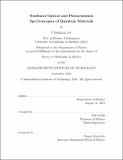| dc.contributor.advisor | Nuh Gedik. | en_US |
| dc.contributor.author | Lee, Changmin, Ph. D. Massachusetts Institute of Technology | en_US |
| dc.contributor.other | Massachusetts Institute of Technology. Department of Physics. | en_US |
| dc.date.accessioned | 2019-01-11T15:04:56Z | |
| dc.date.available | 2019-01-11T15:04:56Z | |
| dc.date.copyright | 2018 | en_US |
| dc.date.issued | 2018 | en_US |
| dc.identifier.uri | http://hdl.handle.net/1721.1/119901 | |
| dc.description | Thesis: Ph. D., Massachusetts Institute of Technology, Department of Physics, 2018. | en_US |
| dc.description | This electronic version was submitted by the student author. The certified thesis is available in the Institute Archives and Special Collections. | en_US |
| dc.description | Cataloged from student-submitted PDF version of thesis. | en_US |
| dc.description | Includes bibliographical references (pages 157-176). | en_US |
| dc.description.abstract | Quantum materials are characterized by a macroscopic behavior that does not have a clear classical counterpart. Among the experimental probes capable of exploring the exotic properties of quantum materials, ultrafast laser pulses can offer a perspective that is not readily accessible with other conventional techniques. With extremely short pulses (10~100 fs), the strength of electric field is strong enough to cause nonlinear optical phenomena in which the frequency of response is different from that of the input. In this thesis, we discuss how second harmonic generation (SHG) and time and angle-resolved photoemission spectroscopy (tr-ARPES) based on high harmonic generation can offer a unique pathway toward studying quantum materials in the context of broken symmetries and nonequilibrium electronic structure, respectively. In particular, we measured the hidden magnetism buried at a topological insulator ferromagnet interface with SHG, and developed a tr-ARPES setup with 16 and 30 meV energy resolutions using 11 and tunable 24~33 eV photons, respectively. Such high photon energy laser pulses allow us to map the nonequilibrium band structure of a large number of quantum materials, as the setup is capable of probing a much wider momentum range compared to previous tr-ARPES experiments. The capability of our setup is demonstrated through the nonequilibrium band structure of ZrTe5, the quasiparticle recombination dynamics of Bi2Sr2CaCu2O8+[delta], and the dynamics of photoinduced replica bands in WSe2. | en_US |
| dc.description.statementofresponsibility | by Changmin Lee. | en_US |
| dc.format.extent | 176 pages | en_US |
| dc.language.iso | eng | en_US |
| dc.publisher | Massachusetts Institute of Technology | en_US |
| dc.rights | MIT theses are protected by copyright. They may be viewed, downloaded, or printed from this source but further reproduction or distribution in any format is prohibited without written permission. | en_US |
| dc.rights.uri | http://dspace.mit.edu/handle/1721.1/7582 | en_US |
| dc.subject | Physics. | en_US |
| dc.title | Nonlinear optical and photoemission spectroscopies of quantum materials | en_US |
| dc.type | Thesis | en_US |
| dc.description.degree | Ph. D. | en_US |
| dc.contributor.department | Massachusetts Institute of Technology. Department of Physics | |
| dc.identifier.oclc | 1079760098 | en_US |
